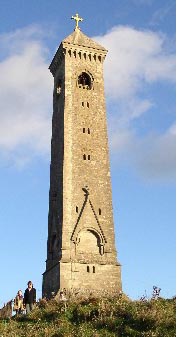The Tyndale Monument
by Joanne Appleton
 If you're driving towards Bristol between junctions 13 and 14 of the M5, look to your left. There you will see the line of the Cotswold escarpment rising above the Severn flood plain. Let your eye travel along the top to a tall tower, apparently perched precariously close to the edge. This is the Tyndale monument at North Nibley: a landmark that can be seen for many miles around, and built in honour of William Tyndale, a man who risked everything to bring us the Bible in everyday language.
If you're driving towards Bristol between junctions 13 and 14 of the M5, look to your left. There you will see the line of the Cotswold escarpment rising above the Severn flood plain. Let your eye travel along the top to a tall tower, apparently perched precariously close to the edge. This is the Tyndale monument at North Nibley: a landmark that can be seen for many miles around, and built in honour of William Tyndale, a man who risked everything to bring us the Bible in everyday language.
Tyndale was born around 1490, possibly near North Nibley. He grew up in the Cotswold area, and after an education at Oxford, worked for a time as a tutor to the Walsh family, of Little Sodbury Manor, near Chipping Sodbury. The privately owned manor still stands today about 13 miles from the monument.
Here Tyndale began his life's work of translating the Bible into the 'language of the plough-boy.' At that time, religion formed a great part of everyday life for all sectors of society. The Bible of those days was in Latin, the language of educated people, so the less well off had to rely on priests to interpret it's meaning. Tyndale however, felt strongly that everyone should have the opportunity to read it for themselves.
His views led to persecution, so he left the Cotswolds in search for a safer place to continue his work. Unable to find support for an English translation in London, he travelled instead to Germany. Copies of his New Testament were produced relatively quickly on the newly invented printing press. Friends risked imprisonment and fines by smuggling the books into England. The authorities responded by burning any copies they discovered.
By the time of his arrest in 1535 Tyndale had translated both the Old and New Testaments. He was sentenced to death and on 16 October 1536 was strangled and burnt at the stake at Vilvorden, near Brussels. His dying prayer: 'Lord open the King of England's eyes' was answered the following year Tyndale's English Bible was printed in England 'with the Kings most gracious licence'. and translation the King James Version of 1611 also follows Tyndale's New Testament very closely.
In 1863, the people of Berkeley decided to honour their famous son by building the tower. The Hon Col Berkeley laid the monument's foundation stone, and the 111-ft high tower was completed three years later in 1866.
A heavy wooden door at the base leads to an inner spiral staircase. It can be narrow in parts although is generally well lit. The climb is worth it however when you are rewarded by breathtaking views across the Cotswolds and over the Bristol Channel to Wales through windows on all four sides.
A nearby topograph erected in 1977 for the Queen Elizabeth 11's Silver Jubilee shows the direction and distance to many other towns and landmarks visible from the site.
The woods surrounding the monument are worth exploring, and it's possible to walk to the historic town of Wotton-Under-Edge for a look round its parish church. From the North Nibley side you can choose the shorter but steeper steps to the monument, or take a gentler stroll along the path and woods.
How to get there:
Leave the M4 at junction 14. Turn left towards Wotton-Under Edge, and left again at the T-junction with Charfield. Go through Wotton, following signs to North Nibley. The entrance to the monument is on your right just before you get to the main village. There is a lay-by on the left for parking.
From Bristol, drive to Chipping Sodbury, take the Wickwar Road to Wotton-Under-Edge, and then follow the signs for North Nibley.
The monument is now open all day every day.
Nearby towns and cities to visit: Wotton-Under-Edge and Kingswood, Gloucester and Cheltenham, Bath, Bristol.
More Information:
We regret that we no longer have the resources to maintain up-to-date links and/or hours and pricing details for the various sites and attractions listed on this website. For more information about the location(s) listed above, please use your favorite search engine or visit Wikipedia.
Joanne Appleton is a freelance writer who lives fifteen miles from Bath. Her idea of the perfect romantic break is to visit as many museums and historic houses as possible; she is a member of English Heritage and National Trust. She has published a variety of historical travel articles in UK magazines.
Article and photo © 2005 Joanne Appleton
| 